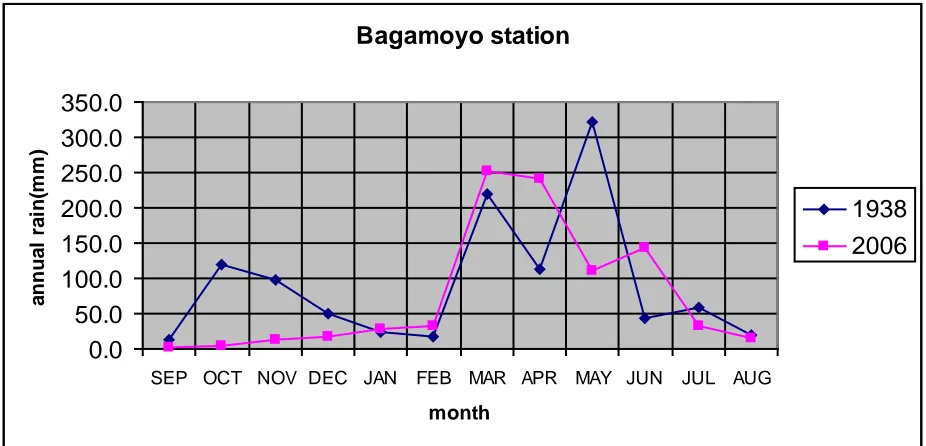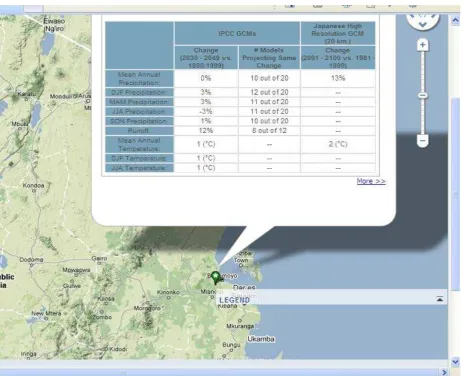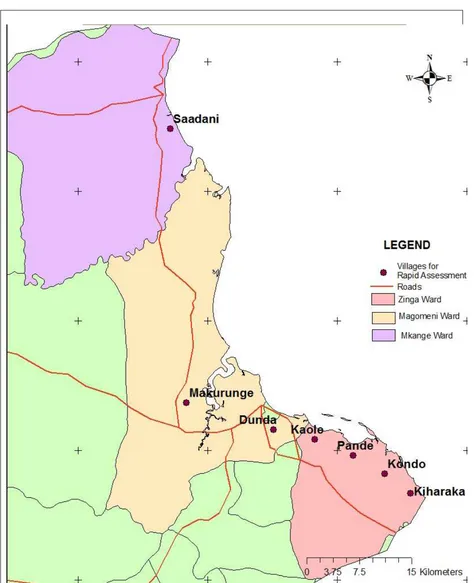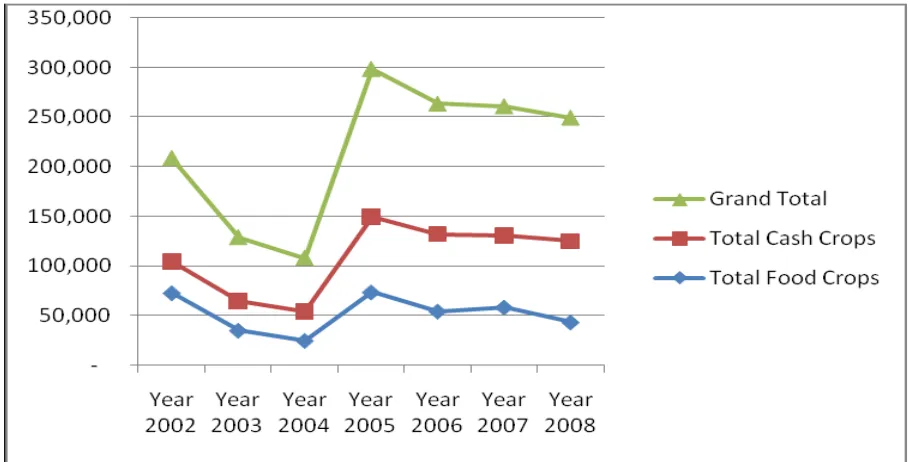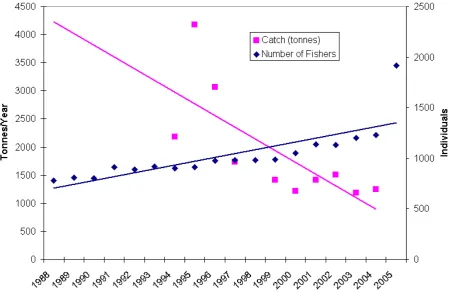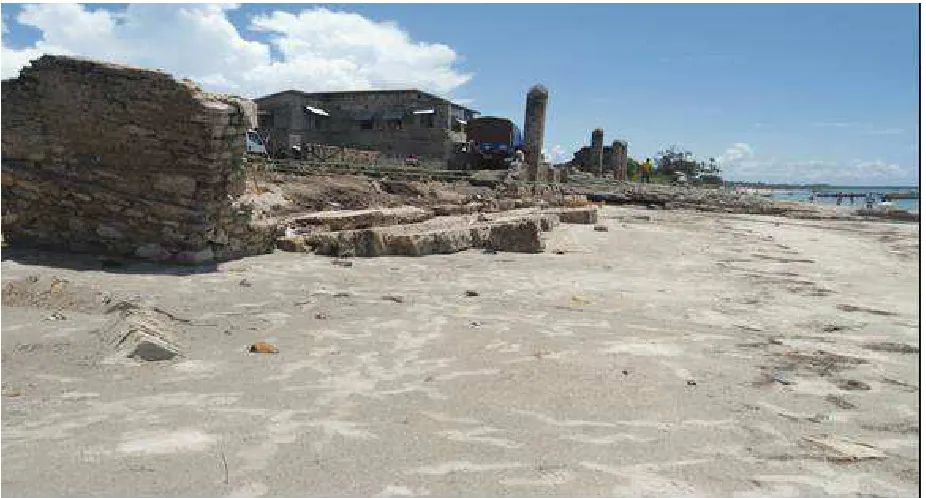Climate Change Adaptation Series: Document 7
LIVELIHOODS, CLIMATE AND NON-CLIMATE THREATS
AND ADAPTATION: BAGAMOYO DISTRICT COASTAL
VILLAGES
June, 2013
Prepared by the Pwani Project
This report is part of the Tanzania Climate Resilient Coastal Communities series, which includes the following documents:
1. Coastal and Marine Ecosystems in a Changing Climate: the Case of Tanzania. 2. Workshop Proceedings: Tanzania Coastal Climate Change National Adaptation
Planning Workshop
3. Village Vulnerability Assessments and Climate Change Adaptation Planning (V & A): Kitonga, Bagamoyo District
4. Village Vulnerability Assessments and Climate Change Adaptation Planning (V & A): Mlingotini, Bagamoyo District
5. Rapid Assessment of Shoreline Characteristics and Dynamics of the Lazy Lagoon at Mlingotini Village, Bagamoyo
6. Livelihoods, Climate and Non-Climate Threats and Adaptation: Pangani District Coastal Villages
7. Livelihoods, Climate and Non-Climate Threats and Adaptation: Bagamoyo District Coastal Villages
8. Village Vulnerability Assessments and Climate Change Adaptation Planning (V & A): Jambiani and Paje, Zanzibar
9. Village Vulnerability Assessments and Climate Change Adaptation Planning (V & A): Kitonga and Mlingotini Villages, Bagamoyo District (Summary Report) 10. Village Vulnerability Assessments and Climate Change Adaptation Planning (V &
A): Mwembeni, Pangani District
11. Village Vulnerability Assessments and Climate Change Adaptation Planning (V & A): Sange, Pangani District
This publication is available electronically on the Coastal Resources Center’s website at http://www.crc.uri.edu. For more information contact: Coastal Resources Center, University of Rhode Island, Narragansett Bay Campus, South Ferry Road, Narragansett, Rhode Island 02882, USA. Tel: (401) 874-6224; Fax: (401) 874-6920.
Citation: Mkama, W., Msuya S., Mahenge , J., Mposo. A, Jason, A.N., Amanzi, A.,
Chausiku. A., Kundengukila, F. (2013). Bagamoyo District Coastal Climate Change Rapid Vulnerability and Adaptive Capacity Assessment , Bagamoyo District, Tanzania. Coastal Resources Center, University of Rhode Island, Narragansett, RI, 26 pp.
List of Abbreviations
BMUs Beach Management Units
CBO Community Based Organization DED District Executive Director
DIDMAC District Disaster Management Committee
DP District Profile
EPMS Environmental Protection Management Services
EPZA/SEZ Export Processing Zone Authority/Special Economic Zone
GDP Gross Domestic Product
MLFD Ministry of Livestock and Fisheries Development NBS National Bureau of Statistic
NGO Non Governmental Organization
SACCOs Saving and Credit Cooperative Societies SMEs Small and Medium Enterprises
SANAPA Saadani National Park
TAFORI Tanzania Forest Research Institute
TCMP Tanzania Coastal Management Partnership TMA Tanzanian Metrological Agency
UNEP United Nations Environmental Program UNHABITAT United Nations Habitat
URT United Republic of Tanzania VPO Vice President’s Office VICOBA Village Community Bank
Table of Contents
List of Abbreviations ... ii
Table of Contents ... 1
List of Figures ... 1
Foreword ... 3
1. INTRODUCTION AND APPROACH ... 4
2. OVERVIEW OF THE BAGAMOYO DISTRICT SITUATION ... 3
2.1 Location and administrative setup ... 3
2.2 Demography ... 3
2.3 Economic activities ... 3
2.3.1 Fisheries ... 3
2.3.2 Mariculture ... 4
2.3.3 Tourism development ... 4
2.3.4 Agriculture and livestock keeping ... 4
2.4 Biophysical characteristics related to climate issues ... 4
2.4.1 Climate... 4
2.4.2 Vegetation ... 7
2.4.3 Drainage... 7
2.5 Rationale for a rapid assessment of coastal community vulnerability and adaptive capacity... 8
3. VULNERABILITY ASSESSMENT RESULTS / SOCIETY ADAPTIVE CAPACITY . 9 3.1 Adaptive capacity category comparison ... 9
3.2 Village adaptive capacity inter-comparison ... 10
3.3 Climate change impact on key sectors in Bagamoyo ... 12
3.3.1. Agriculture ... 12
3.3.2 Fisheries ... 13
3.3.3 Tourism ... 13
3.4 Indigenous sustainable adaptation options ... 14
4. CONCLUSION AND RECOMMENDATIONS ... 16
Governance and leadership (GL) ... 16
Coastal Resources Management (CRM) ... 16
Risk Awareness and Emergency Response (RA) ... 17
Economy and Society (ES) ... 17
REFERENCES ... 19
APPENDIX 1 ... 21
List of Figures Figure 1 Temporal annual variation of rainfall, Bagamoyo Rain Station ... 5
Figure 2 Mean monthly rainfall variation Data source: Tanzania Meteorological Agency, 2008... 5
Figure 3 Climate change projection for Bagamoyo area ... 7
Figure 4 Location of villages included in assessment ... 11
List of Tables
Table 1 Climate change Projections in Bagamoyo ... 6
Table 2 Vulnerability/adaptive capacity scores for assessed villages ... 10
Table 3 Summary of the different existing adaptation options ... 15
Foreword
Climate change is a global issue posing challenges to the very survival of mankind and preventing sustainable development. The adverse potential impacts of climate change are now evident in Bagamoyo District. Bagamoyo District villages are exposed to climate change and non-climate related stresses. The impacts pose danger to livelihoods, social assets and the natural environment.
This report seeks to understand the vulnerabilities specific to coastal communities in the District with the view of providing guidance for planning directed at improving livelihood resilience and reducing vulnerability in communities to climate and non-climate stressors. Bagamoyo District appreciates the assistance of the University of Rhode Island’s Pwani Project in carrying out this effort and invites village leaders in all Bagamoyo villages to learn from the findings in this report.
1. INTRODUCTION AND APPROACH
There is now wide agreement by most scientists and climate change professionals that climate change and increased climate variability are already occurring and having serious consequences for many African countries, including Tanzania. The predictions from the experts on climate change are that the problems caused by climate changes will increase and make management of coastal ecosystems and improvements to community resilience even more difficult. The following threats are predicted to cause major problems for coastal resources and the well-being, safety, and food security of coastal communities:
1. More unpredictable precipitation (seasonality and intensity) 2. Increases in strong storms
3. Sea level rise
4. Increased sea surface and ambient air temperatures 5. Increased ocean acidification
These climate and chemical threats and the problems they create are in addition to existing local stresses such as deforestation, over fishing, deterioration in water supply and quality, and development pressures.
Beginning in 2010, the University of Rhode Island’s Pwani Project initiated an effort to help local leaders and government to assess climate change impacts and find ways to adapt to current and future climate change impacts in a strategic way using their own resources and knowledge. This is part of a larger coastal management effort in a partnership with the government of Tanzania and the United States Agency for International Development
(USAID). The Pwani Project has a geographic focus on the island of Unguja in Zanzibar and the ecologically important northern coast of mainland Tanzania – Bagamoyo and Pangani Districts. The overall goal is to help sustain the flow of environmental goods and services; revise the trend of environmental destruction of critical coastal habitats; and improve the wellbeing of coastal residents in the Bagamoyo-Pangani and Menai Bay Seascapes.
This report documents climate change susceptibility and exposure of the marine dependent livelihood for selected coastal villages in Bagamoyo district in order to help set priorities for scaling up community level vulnerability and adaptation planning. The villages of Kitonga and Mlingotini are among the pioneers in local adaptation planning in coastal Tanzania. This assessment employs a qualitative approach to determine likely community vulnerability to the impacts of climate change, incorporating an initial understanding of their adaptive capacity. The selected locations represent the coastal and marine resource dependent community vulnerability. The assessment examines the most susceptible factors to climate change which in turn affect livelihood of the Bagamoyo community.
resource governance. Selected coastal villages include Makurunge, Kiharaka, Kaole, Dunda, Pande, Kondo and Saadani.
Approaches for the assessment included transect walks, key informant interview, and focus group discussion. Before the transect walk, the village resource map was drawn and the transect line drawn. A transect table was be drawn and used to collect climate change affected natural resource information. Key informant interviews were used to get vulnerability
information from village leaders, extension officers, famous villagers and elders.
2. OVERVIEW OF THE BAGAMOYO DISTRICT SITUATION
This section outlines the general overview of Bagamoyo district. It details biophysical and socio-economic overview characteristics of the district. The section outlines the districts’ location, population dynamics, existing economic activities, biophysical characteristics, that is, district climate, vegetation and drainage. The section also emphasizes on the rationale of conducting the coastal district vulnerability assessment.
2.1 Location and administrative setup
Bagamoyo is one among six districts of the Coastal (Pwani) Region of Tanzania. Bagamoyo District is situated 75 km north of Dar-es-Salaam (UNH, 2009). It is bordered to the north by the Tanga Region, to the West by the Morogoro Region, to the East by the Indian Ocean and to the South by the Kinondoni and Kibaha Districts (Bagamoyo District, 2009).
Bagamoyo District lies between 370 and 390 Longitude and between 60 and 70 Latitude (DP, 2006; 2009). The district covers an area of 9,842 km2 , where 855 km2 is covered by water (Ocean and river) while the remaining part, which is 8,987 km2 is occupied by dry lands (Bagamoyo District,2009). The District has two parliamentary constituencies that are Bagamoyo and Chalinze. It is divided into six administrative divisions and sixteen wards (Bagamoyo District, 2006). The district capital is Bagamoyo town.
2.2 Demography
According to the 2012 Tanzania National Census, the population of the Bagamoyo district is 311,740; with 154,198 males and 157,542 females with the average household size is 4.4 (NBS, 2013).The population of Bagamoyo now is highly mixed due to migration and settlement of different ethnic groups. Existing ethnic groups include the Kwere, Zaramo, Zigua, Doe and Masai.
2.3 Economic activities
The main economic activities in Bagamoyo include small holder farming, artisanal fishing, livestock keeping, mariculture (sea weed and prawn farming), salt production, trade, and tourism. Bagamoyo area has become an important cultural, beach and conference tourist hub along the coast of Tanzania (http://www.tanzania.go.tz/regions/COAST.pdf as of March, 2013). This transformation has both created social and economic development opportunities while adding new to the key economic and social challenges facing the area. This is one of the factors resulting into Bagamoyo acquiring small township status that needs further infrastructure upgrading.
2.3.1 Fisheries
2.3.2 Mariculture
Mariculture has contributed to the ability of some Bagamoyo communities to improve family incomes as a supplement to traditional income sources. Seaweed farming is one of
mariculture activities in the district (example Mlingotini village). In order to maintain and increase income generated from seaweed farming, some villages, with the aid of TCMP-PWANI project engaged in seaweed related products like soap and skin oil making. The sale of seaweed itself generates little income compared to product generated from seaweed hence seaweed related product making is the main driving force for the activity. Prawn farming and crab fattening is mainly practiced at Mbegani Fisheries Development Centre (Mutatina, 2008).
2.3.3 Tourism development
Bagamoyo District is blessed with an amazing historical and cultural heritage and was recently designated a United Nations Educational, Scientific, and Cultural Organization (UNESCO) World Heritage Site (UNH, 2009). Bagamoyo has developed beach hotels that attract many visitors from Dar es Salaam. Most of the facilities are within 60 meters the highest tidal mark which is the limit for development activities. Issues such as access to beach; waste (liquid and solid) and visual impacts are of concern to local people and visitors.
2.3.4 Agriculture and livestock keeping
Although agriculture is facing a number of climate hazards, coastal communities still depend on it heavily as a livelihood. Agricultural activity is largely subsistence and low value crops (Andrew, 2009; Mushi, 2009). Common cash crops in the district are coconut, fruits, cashew nuts, sesame and cotton while important food crops include maize, sorghum, paddy, cassava, legumes and sweet potatoes (Bagamoyo District, 2009)
Livestock in Bagamoyo district include Cattle, Goats, Sheep, Pigs, Donkeys, Dogs, Cats, Horses, Camels Chicken and Ducks. The district is gradually receiving large influx of livestock keeper every year due to limited pasture and water in upcountry pastoral regions. Good grazing area and adequate water supply along Wami and Ruvu river systems attractive livestock keepers. The major source of land conflict in the district is high resource use competition between farmers and livestock keepers, for example there is a growing concern of grazing big cattle herds along in SANAPA along the Wami –Ruvu river.
2.4 Biophysical characteristics related to climate issues
2.4.1 Climate
The humid tropical climate has a seasonal average temperature ranging from 130 C- 300 C and humidity as high as 98% (EPMS, 2006) covers Bagamoyo district. Rainfall ranges between 800 – 1200 mm per annum. The short rain (vuli) season start from October to December while the long rain (masika) season starts from March to May (District Profile, 2006; Andrew, 2009; Mushi, 2009).The driest months are June to September when monthly rainfall is generally less than 50 mm per month.
Figure 1 Temporal annual variation of rainfall, Bagamoyo Rain Station
Data source: Tanzania Meteorological Agency, 2008
The mean monthly variation of rainfall between two distant years, 1938 and 2006(Figure 4) documents that in 1938 rainfall were higher in Vuli but now it had decreased considerably. However, in Masika the rainfall is still available but marginally lower than in the past. Apparently, the rains in Masika appear to come earlier than before. It is noted that rains ceased earlier than before. For example, in 1938 rains in May were higher than the rains during the similar period in 2006.
Figure 2 Mean monthly rainfall variation Data source: Tanzania Meteorological Agency, 2008
From the World Bank Climate data portal (http://sdwebx.worldbank.org/climateportal/) , Bagamoyo climate projection analysis shows projection using various General Circulation Model (GCM) (Table 1 and Figure 3). Based on the IPCC, GCM it was predicted that in Bagamoyo, the Mean annual rainfall will increase by 1 % while the mean annual temperature
Bagamoyo rainfall station
1920 1930 1940 1950 1960 1970 1980 1990 2000
Year
SEP OCT NOV DEC JAN FEB MAR APR MAY JUN JUL AUG
will increase by 10C . Runoff will increase by 15% a situation which contributes to floods. Japanese model has predicted Mean Annual rainfall to increase by 4% while Annual mean temperature increase will be by 4%
Table 1 Climate change Projections in Bagamoyo
Projections
IPCC GCMs Japanese
Resolution GCM (20km)
Change (2030-2049) vs
(1980-1999)
#Models
Projecting same change
Change
(2091-2100) vs (1981-1990)
Mean Annual Rainfall 1 % 12 out 20 4 %
Dec, Jan, Febr Rainfall 4% 14 out 20 -
March , April, May Rainfall 4% 13 out 20 - June, July August Rainfall -3% 12 out 20 -
Sept, Oct, Nov rainfall 0% 10 out 20 -
Runoff 15 % 9 out 20 -
Mean Annual Temperature 10 C - 20 C
Dec, Jan, Febr Temperature 10 C - -
June, July , August Temperature
Figure 3 Climate change projection for Bagamoyo area
Source: (http://sdwebx.worldbank.org/climateportal/.)
2.4.2 Vegetation
The Bagamoyo District Profile (2009) classified land cover and the vegetation into two (2) ecological zones. The coastal strip is characterized by savannah and bush; in contrast to the East North and Western up country which is covered with natural dense forest .The coastal strip usually receives relatively more precipitation than the upcountry part (Bagamoyo District, 2006).The general district topography is characterized by gentle undulating plains covered by sparce vegetation . Mangroves swamps and trees cover the costal belt. Dominant soil types include Sand, Loamy, Sandy- loamy and clay soils (Bagamoyo District, 2006)
2.4.3 Drainage
2.5 Rationale for a rapid assessment of coastal community vulnerability and adaptive capacity
Bagamoyo coastal communities have experienced climate change impacts on their livelihoods (NAPA, 2007). Climate change effects on fishery and agricultural livelihoods have forced coastal farmers to explore ways to adapt to the existing climate shifting patterns (IUCN, 2009). These small adaptation actions are of great importance to Bagamoyo
communities as they pursue more sustainable livelihoods (Raihan et al., 2010).
3. VULNERABILITY ASSESSMENT RESULTS / SOCIETY ADAPTIVE CAPACITY
3.1 Adaptive capacity category comparison
Each village was rated on 40 different questions linked to four main themes: Governance and leadership
Coastal Resources Management (CRM)
Risk Awareness and Emergency Response (RA) And Economy and Society (ES)
The raw scoring is not reported here, rather summarized in Table 1 by location and by theme based upon the fraction of total possible score for each factor. Overall, governance and leadership was rated the highest and risk awareness/emergency response the lowest. Coastal resource management was the second highest rated capability followed by economy and society aspects. (Table 1). Governance and leadership capacity scores may be linked to changes in District administration as a result of disciplinary actions from Prime Minister’s Office Regional Administration and Local Government (PMO-RALG). Central government has taken on a strong measure of control of Bagamoyo district decisions. Coastal resource management’s relatively high rating could be influenced in part by a decade of TCMP work in Bagamoyo promoting coastal community good governance. More recently a number of NGO s have expanded their work in Bagamoyo communities to promote good natural resource governance.
Risk awareness and economy of the society fall well below the district average. . The major source of income in Bagamoyo’s coastal communities is fisheries and small scale agriculture which are all climate dependent. There has also been a gradual shift to alternative sources of income such as upcoming tourism industry, new infrastructure providing new employment opportunities, and increasing socio-economic supporting NGOs.
The very low risk awareness scores in the villages examined is due to the very limited district engagement in natural hazard and climate change adaptation activities. A few projects like PWANI, conducted selected vulnerability assessment and facilitated small doable adaptation and CBOs such as the Bagamoyo Non-Governmental Organization Networking
Table 2 Vulnerability/adaptive capacity scores for assessed villages
ADAPTIVE CAPACITY CATEGORY
Scores represent fraction of total possible score for the category Villages Governance
3.2 Village adaptive capacity inter-comparison
Bagamoyo villages exhibit a wide range of adaptive capacity scores. Some villages are above the district average capacity and some are well below (Table 2) For example, Makurunge, Dunda, and Pande have scores for adaptive capacity that are above the district average, but for different reasons. Makurunge village has fairly strong leadership that is closely influenced by its proximity to Bagamoyo town due to the new town setup. The village also scored the highest in natural resources management.
Pande village is very close to the district administrative center. The village has strong
leadership and fair risk awareness. Risk awareness is due in part to PWANI previous climate change activities, and district promotion of alternative livelihoods due to fish catch fall. On the other hand some villages like Kiharaka and Kondo are among those with less adaptive capacity. Kiharaka has local governance problems, low risk awareness with few alternative livelihood sources. The village’s main source of income has remained to be fisheries and agriculture which are all climate dependent. The village has a lot of land disputes due since it borders Dar es Salaam whose population is growing very fast. Kondo village has slightly below district average risk awareness due to the NGOs and district preference working with the neighbor Mlingotini village. The Kondo economy is also weak due to high dependence on climate dependent livelihoods
3.3 Climate change impact on key sectors in Bagamoyo
3.3.1. Agriculture
From the key informants and interviews conducted it was noted that apart from fisheries and ecotourism, agriculture is an increasing activity for the typical Bagamoyo resident. District officials and village key informants pointed to decreased production of both food and cash crops in recently years is among other factors caused by changing climate patterns and shift in seasons. For example, in 2005 the production was at its peak, and gradually dropping in 2006 through 2008.Overall the general trend shows decreasing in production with exception of 2004/2005 increment (Figure 5).
Figure 5 Bagamoyo cash and food production trend
3.3.2 Fisheries
Bagamoyo is one of the prominent fishing districts in Tanzania. Conducted survey indicated that apart from increasing effort and bad fishing practices, increasing temperature is the major concern contributing to low catch for most of the fishers. For example, artisan fishers conduct fishing activities mainly near shores and in coral reefs. To get good catch during hot seasons, fishers’ have to go further seaward. With poor vessels and gears, deep sea fishing is not possible in many cases resulting into the decrease in the catch per unit effort (Figure 6).
Figure 6 Artisanal Catch and Number of Licensed Fishers In Bagamoyo District
Source: Bagamoyo District Natural Resource Office, 2005, reproduced from Coastal Resources Center, 2005).
3.3.3 Tourism
Bagamoyo community has shown that coastal tourism related natural resources are
vulnerable to coastal erosion and shoreline changes. Villagers have witnessed eroded beaches and shifting shorelines. These have affected old historical buildings, bomas, and have
Figure 7 Beach erosion collapsing old Boma important tourist visit areas at “Kastamu/Customs”, Bagamoyo
3.4 Indigenous sustainable adaptation options
.
Table 3 Summary of the different existing adaptation options
Village Potential adaptation activity
Kiharaka Irrigated gardening from piped water and Mpigi river 1
Cassava farming
Existence of Women VICOBA supported by CARE to support small scale business and diversify livelihood.
Free villagers mason training offered by the Catholic church Pande A few women practice vegetable small scale irrigation
Change in livelihood and employ non climate dependent activities The use of natural drought resistant crops(Cassava)
The presence of VICOBA as supported by CVM/APA Kondo Cassava growing
Livelihood diversification, i.e. Beekeeping
Fisheries to petty businesses
Dunda Shift in socio economic activities, i.e from fishing/agriculture to petty and tourism business and masons
Cassava cultivation
Migration to more agricultural productive areas, for example Kiwangwa. Kaole Incorporate villagers into village growing economy by:-
• Establishing tourism market center where villagers could sell local commodities
• Rationing part of the Kaole antiquity earnings to the village governments
• Employ unskilled and semi-skilled manpower to the forthcoming nearby EPZ/SEZ.
Enhance alternative livelihood by providing technical support and value add to sell to tourists and Kaole growing population
Providing access to small grants such as SACCOs
Makurunge Shift livelihoods, i.e. Fishing and upland farming to lumbering Adopt additional crops form immigrants(Pineapples)
The village government has village reserved land for future planning District distributed early maturing crops such as Cassava and maize Awareness raising by NGOs such as Red cross
Saadani Migration to other villages for agricultural activities i.e. from Saadani to Mkange village
Shift of livelihoods from agriculture and fishing to saltworks, and petty business
School water harvesting tanks
4. CONCLUSION AND RECOMMENDATIONS
This assessment has yielded observations of climate change signals in Bagamoyo district. The district has evidence of shoreline changes, beach erosion, unreliable rainfall and
increasing temperatures in dry seasons. These have seriously affected Bagamoyo community coastal agriculture, fisheries and partly booming tourism industry. Unless there are serious efforts to adaptation, the district is vulnerability to the impacts of climate change will
increase in a few decades. Increased district vulnerability will also have a multiplier effect to the country’s GDP. Recommended actions to minimize climate change impacts from a district wide perspective fall into the four main themes addressed in the assessment. Every one of the villages reviewed in this assessment would benefit from an individualized vulnerability assessment.
Governance and leadership (GL)
Although most of villagers get climate change extreme weather condition information
thought radios, they do not have adequate knowledge on adaptation/coping measures to take. The district should consider upgrading existing “information section” which is under DEDs office to disseminate information and promote knowledge on adaptation and/or coping mechanism to village level. The information section can also attract investors to set up district radio specials to discuss district issues, climate change adaptation included.
Currently issues pertaining to climate change adaptation have no specific funds allocated and are addressed as emergency cases under DIDMAC. In order to secure permanent fund from the central government for adaptation, special capacity building attention needs to be made to village leaders at grassroots. This is because the Government of Tanzania has adopted
“Bottom up” planning approach which will allow adaptation funds planned from the village priorities.
Coastal Resources Management (CRM)
Bagamoyo community residents have some indigenous adaptation measures that villagers use to survive. Though these measure have low productivity due to lack of expertise and
extension service, there need to enhance and provide technical assistance to indigenous adaptation options. This value addition to existing knowledge will increase efficiency and save time and money to successful adaptation.
climate change adaptation. For example instead of planting mere fast growing trees, three departments could have a combination of fruit trees that will benefit community around and provide an incentive to conserve the forest. Nectar from pollinating fruit trees will also serve beekeeping activities. The sale from fruits and honey will provide and alternative source of income and good health to the community. Alternative source of income, good health and sustainable less climate dependent livelihood (beekeeping) contribute significant in build a resilient community.
TAFORI is tasked to closely work with district to produce sound results to the central government decision makers. This collaboration can be well utilized by the district to request for research on different tree and tree products that adapt to climate changes. For example forest departments would request research on improved tree varieties that withhold nectar for a long time or have long time seasonal flowering to serve beekeeping as an alternative livelihood to climate change.
Risk Awareness and Emergency Response (RA)
Bagamoyo district has a weather gauging station which has only rainfall reliable data. The station has to transfer data to TMA for analysis and processing into secondary usable form. To improve efficiency in climate change adaptation, the district in collaboration with the agency may consider the upgrade the water gauging station to weather forecast small town satellite station. Information obtained from the station will directly be utilized by
DIDAMAC, fisheries, and agriculture and water sectors at district level to make appropriate adaptation decisions. The information section under DEDs office can also us the information to directly alert villages to take appropriate adaptive decisions.
Economy and Society (ES)
District community development department has the mandate to coordinate NGOs and/or CBOs activities pertaining to community wellbeing in the district. From African context and climate change perspective, vulnerable groups whose wellbeing need close attention include women, children, disabled and people living with HIV/AIDS. Community development department has an opportunity to use the CBO/NGO coordination function to introduce the climate change adaptation of concept to all CBOs/NGOs activities to improve the wellbeing of the marginalized and community. The department has also an opportunity to scale up existing TCMP-PWANI project pilot demo adaptation activities in Bagamoyo to other NGOs and/or CBOs
Like the rest of the districts, DADPs program under the ministry of food security and
irrigation has been operating in Bagamoyo. The program offers opportunity secure alternative livelihoods, SMEs trainings and technical support, and improved seed variety
experimentation and distribution. The program has been successful in non-coastal villages but has limitation to Bagamoyo coastal villages due to the threat of EPZ establishment. On other hand, the district has an opportunity to use the program to establish climate change adaptation intellectual capacity building and facilitate movable livelihoods that cannot be affected upon establishment of EPZ. Moreover, with EPZ established, the program can establish strategies for accessible and reliable cash crop markets for small scale farmers
Bagamoyo district has collaborations with Chambezi Experimental station, a substation of Mikocheni Agricultural Research Institute under the Ministry of food security and irrigation. Collaboration strengthened can result into agriculture department increased efficiency in obtaining and distributing improved climate change adaptive seeds and crops to subsistence coastal smallholder farmers. This is because Chambezi Experimental station is utilizing Bagamoyo weather to experiment on crops and seeds developed, and is near Bagamoyo town thus saves cost and time.
Tourism is one of the major booming activities in Bagamoyo town. According to the district forest officers, the use of tourism value forest non-wood products is still low. Value addition of forest non-wood products such as curving, ornament, tested and certified herbal
REFERENCES
Andrew, B., (2009).The role of indigenous knowledge in adaptation to climate change and variability: The case of Bagamoyo district. Msc. University of Dar es Salaam
Bagamoyo District. (2006). The Bagamoyo District Profile. Bagamoyo District, Tanzania. EPMS, 2006. Adaptation to climate change through shifting of shallow water wells affected by inundation on the coast regions-Bagamoyo. South-North Adaptation Team, Dar es Salaam.
Coastal Resources Center. (2005), Community-based Fisheries Management Plan, July 2005 – July 2006. Manuscript. Coastal Resources Center, University of Rhode Island, 28 pp. Mushi, R.S, (2009). Climate change and its impacts on the coastal tourism in Bagamoyo district. Msc. University of Dar es Salaam.
Mutatina, A. (2008). Interactive governance approach in mariculture activities in Tanzania. 105pp.
Ministry of Livestock Development and Fisheries (MLDF) (2010a); Marine Fisheries Frame survey results, Dar es Salaam: Ministry of Livestock Development and Fisheries.
National Bureau of Statistics (NBS), (2006). Pwani Regional and districts projections. United Republic of Tanzania Volume xii. 194pp.
National Bureau Of Statistics (NBS) And Coast Regional Commissioner’s Office (2007) Coast Region Socio-Economic Profile. Co-Ordinated By: Ministry Of Planning, Economy And Empowerment Dar Es Salaam. Second Edition June 2007
http://www.tanzania.go.tz/regions/COAST.pdf as of March, 2013
National Bureau of Statistics and Office of Chief Government Statistician (2013). 2012 population and housing census. Population distribution by administrative areas. 244pp. Ngana, J.O, Liwenga E.T, Maganga F.P; Lyimo J.G. (forthcoming) Climate Change and Variability in Coastal Areas of Tanzania: Towards Sustainable Adaptation Strategies. Sosovele, H., undated. Bagamoyo area Economic and social briefing
Tanzania Coastal Management Partnership (TCMP). (2007). Ecological monitoring of coral reef in no-take and fished zones off Bagamoyo and Mkuranga coasts, Tanzania Coastal Management Partnership and the Coastal Resources Center, University of Rhode Island. Tanzania Meteorological Agency. (2008) Mean monthly rainfall variation data.
APPENDIX 1
Table 4 Transect walk GPS points
